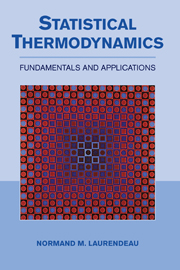Book contents
- Frontmatter
- Contents
- Preface
- 1 Introduction
- PART ONE FUNDAMENTALS OF STATISTICAL THERMODYNAMICS
- PART TWO QUANTUM MECHANICS AND SPECTROSCOPY
- 5 Basics of Quantum Mechanics
- 6 Quantum Analysis of Internal Energy Modes
- 7 The Spectroscopy of Diatomic Molecules
- Problem Set III Quantum Mechanics and Spectroscopy (Chapters 5–7)
- PART THREE STATISTICAL THERMODYNAMICS IN THE DILUTE LIMIT
- PART FOUR STATISTICAL THERMODYNAMICS BEYOND THE DILUTE LIMIT
- PART FIVE NONEQUILIBRIUM STATISTICAL THERMODYNAMICS
- PART SIX THE ENSEMBLE METHOD OF STATISTICAL THERMODYNAMICS
- PART SEVEN APPENDICES
- Index
5 - Basics of Quantum Mechanics
Published online by Cambridge University Press: 05 June 2012
- Frontmatter
- Contents
- Preface
- 1 Introduction
- PART ONE FUNDAMENTALS OF STATISTICAL THERMODYNAMICS
- PART TWO QUANTUM MECHANICS AND SPECTROSCOPY
- 5 Basics of Quantum Mechanics
- 6 Quantum Analysis of Internal Energy Modes
- 7 The Spectroscopy of Diatomic Molecules
- Problem Set III Quantum Mechanics and Spectroscopy (Chapters 5–7)
- PART THREE STATISTICAL THERMODYNAMICS IN THE DILUTE LIMIT
- PART FOUR STATISTICAL THERMODYNAMICS BEYOND THE DILUTE LIMIT
- PART FIVE NONEQUILIBRIUM STATISTICAL THERMODYNAMICS
- PART SIX THE ENSEMBLE METHOD OF STATISTICAL THERMODYNAMICS
- PART SEVEN APPENDICES
- Index
Summary
We found in the previous chapter that the molecular partition function is required to determine the thermodynamic properties of an ideal gas. To evaluate the partition function, specification of pertinent energy levels and degeneracies is necessary. Such knowledge demands that we investigate at least the rudiments of quantum mechanics, and especially those quantum concepts required for subsequent applications to statistical thermodynamics. For this reason, we concentrate in the next few chapters on the Schrödinger wave equation, whose various solutions provide the εj's and gj's needed for the eventual calculation of thermodynamic properties. Depending on your academic background, you might thus consider reviewing classical mechanics (Appendix G) and operator theory (Appendix H) in preparation for your upcoming study of quantum mechanics.
We begin this chapter with a historical review of the developments leading to the formulation of quantum mechanics, subsequently focusing on the Bohr model for atomic hydrogen and the de Broglie hypothesis for matter waves. We then introduce the Schrödinger wave equation, the basic postulates of quantum mechanics, and salient insights from these postulates germane to the development of statistical thermodynamics. We next apply the Schrödinger wave equation to the translation energy mode of an atom or molecule. This application conveniently explains both quantum states and quantum numbers, including their relation to our previous notions of microstate and macrostate. We end this chapter by discussing the Heisenberg uncertainty principle, including its utility in defining indistinguishability and symmetry conditions for multiparticle systems.
- Type
- Chapter
- Information
- Statistical ThermodynamicsFundamentals and Applications, pp. 69 - 96Publisher: Cambridge University PressPrint publication year: 2005



